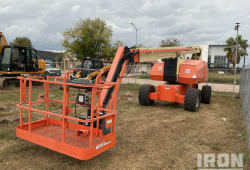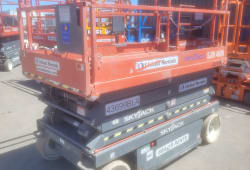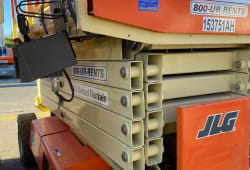Explore The Importance of Lifts in the Logistics Industry
7 Min read
)
November 25, 2023
The logistics industry is a complex and rapidly evolving sector that plays a crucial role in the global economy. As businesses strive for efficiency and productivity, the role of lifts in the logistics industry has become increasingly significant. Lifts, whether they are elevators, hoists, or conveyor systems, serve as indispensable tools in the movement and handling of goods within warehouses and distribution centres. This article delves into the various types of lifts used in logistics and explores their impact on the efficiency and overall functioning of the industry.
The Evolution of Lifts in Logistics
The integration of lifts in logistics can be traced back to the early days of industrialization when manual labour was the primary means of transporting and handling goods. As the scale of operations grew, so did the need for more efficient and time-saving methods. This led to the development of mechanical lifts and conveyor systems, revolutionising the logistics landscape.
Types of Lifts in Logistics
Elevators:
Elevators play a pivotal role in vertical transportation within warehouses and distribution centres. These lifts are essential for moving goods between different floors, allowing for optimised use of vertical space. With the ability to lift heavy loads efficiently, elevators contribute significantly to streamlining the logistics process.
Hoists:
Hoists are another vital type of lift commonly used in logistics. They are instrumental in lifting and manoeuvring heavy items, enabling the swift and safe transfer of goods within a facility. Hoists are particularly valuable in scenarios where manual lifting would be impractical or pose a safety risk to workers.
Conveyor Systems:
Conveyor systems are an integral part of modern logistics, providing a continuous and automated means of transporting goods. These systems use lifts to move items between different levels of a facility seamlessly. The efficiency and speed of conveyor systems contribute to faster order fulfilment and increased productivity in logistics operations.
The Impact of Lifts on Logistics Efficiency
Time Efficiency:
One of the primary advantages of incorporating lifts into logistics operations is the significant time savings they offer. Elevators, hoists, and conveyor systems streamline the movement of goods, reducing the time required to transport items within a facility. This time efficiency translates to faster order processing and ultimately improves customer satisfaction.
Space Optimization:
Lifts play a crucial role in optimising space utilisation within warehouses. Vertical transportation facilitated by elevators allows businesses to make the most of available vertical space, which is particularly valuable in high-density urban areas where land is scarce and expensive. This space optimization contributes to cost savings and improved logistics infrastructure.
Reduced Manual Labor:
The integration of lifts in logistics minimises the reliance on manual labour for lifting and transporting heavy items. This not only enhances the safety of workers but also allows businesses to allocate human resources more strategically. By automating repetitive and physically demanding tasks, lifts contribute to a more efficient and streamlined logistics workflow.
Challenges and Innovations in Lift Technology
While lifts have become indispensable in the logistics industry, there are challenges and opportunities for innovation that continue to shape the sector. Maintenance and downtime can be significant concerns, prompting the need for advanced monitoring systems and predictive maintenance technologies. Innovations in lift technology, such as smart sensors and data analytics, are helping address these challenges, ensuring that lifts operate at peak efficiency and minimising disruptions in logistics operations.
The Future of Lifts in Logistics
As the logistics industry embraces technological advancements, the future of lifts holds even more promise. Emerging technologies such as automation, robotics, and artificial intelligence are reshaping the way lifts operate within logistics facilities. Automated guided vehicles (AGVs) and robotic arms integrated with lifts are becoming increasingly common, enabling a higher degree of autonomy in material handling processes.
Automation and Robotics:
The integration of lifts with automation and robotics is a game-changer in logistics. Automated systems, guided by sensors and AI, can efficiently manage the movement of goods, optimising the entire supply chain. Lifts equipped with robotic arms can pick, place, and organise items with precision, reducing the need for human intervention in routine and repetitive tasks.
Data-Driven Decision Making:
Lifts are becoming smarter with the incorporation of data-driven technologies. Advanced sensors and monitoring systems provide real-time data on lift performance, maintenance needs, and overall operational efficiency. This data is invaluable for logistics managers, allowing them to make informed decisions, predict potential issues, and implement preventive measures to minimise downtime.
Integration with Internet of Things (IoT):
The Internet of Things (IoT) is revolutionising the logistics landscape, and lifts are no exception. Lifts equipped with IoT technology can communicate with other devices and systems within a logistics facility, creating a seamless network of interconnected processes. This connectivity enhances coordination, allowing for a more synchronised and efficient logistics workflow.
Energy Efficiency:
The logistics industry is increasingly focused on sustainability, and lifts are no exception. Future lift technologies are likely to emphasise energy efficiency, incorporating features such as regenerative braking systems and low-power modes. These innovations not only contribute to environmental sustainability but also result in cost savings for logistics operators.
Adaptability and Flexibility:
The dynamic nature of the logistics industry requires lifts to be adaptable and flexible. Future lifts will likely be designed to handle a wide range of goods, from small packages to large, irregularly shaped items. The ability to quickly reconfigure lift systems to accommodate changing operational needs will be a key factor in maintaining competitiveness in the logistics sector.
Last-Mile Delivery Solutions:
As e-commerce continues to thrive, the importance of efficient last-mile delivery solutions cannot be overstated. Lifts, especially those integrated into automated delivery systems, can play a crucial role in streamlining the last leg of the supply chain. Drones and delivery robots, connected to lift systems, can facilitate faster and more precise last-mile deliveries, meeting the growing demand for timely and convenient services.
Challenges and Considerations
While the future of lifts in logistics holds immense potential, there are challenges that must be addressed. Cybersecurity concerns, the need for standardised communication protocols, and the upfront costs associated with implementing advanced lift technologies are some of the hurdles that the industry must navigate. Additionally, there may be resistance to adopting fully automated systems due to concerns about job displacement and the need for human oversight in certain scenarios.
The End
The role of lifts in the logistics industry cannot be overstated. Elevators, hoists, and conveyor systems have become integral components of modern logistics, contributing to increased efficiency, space optimization, and reduced manual labour. As the logistics landscape continues to evolve, innovations in lift technology will play a crucial role in overcoming challenges and further enhancing the industry's capabilities. Businesses that recognize the importance of lifts and invest in advanced lift technologies are poised to stay competitive in an ever-changing logistics environment.














